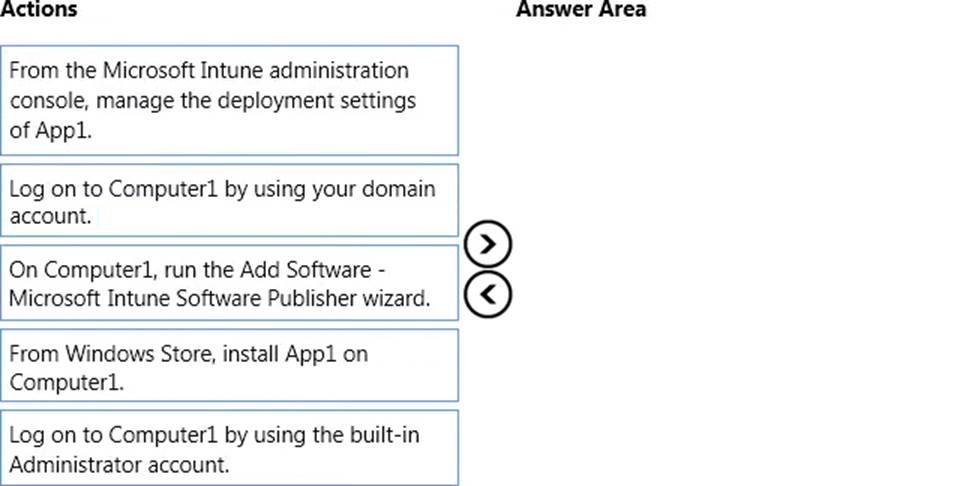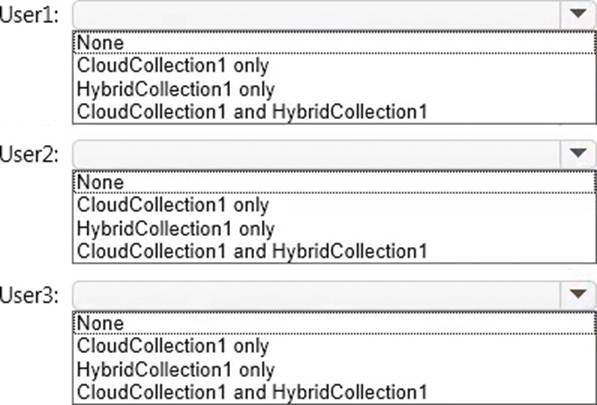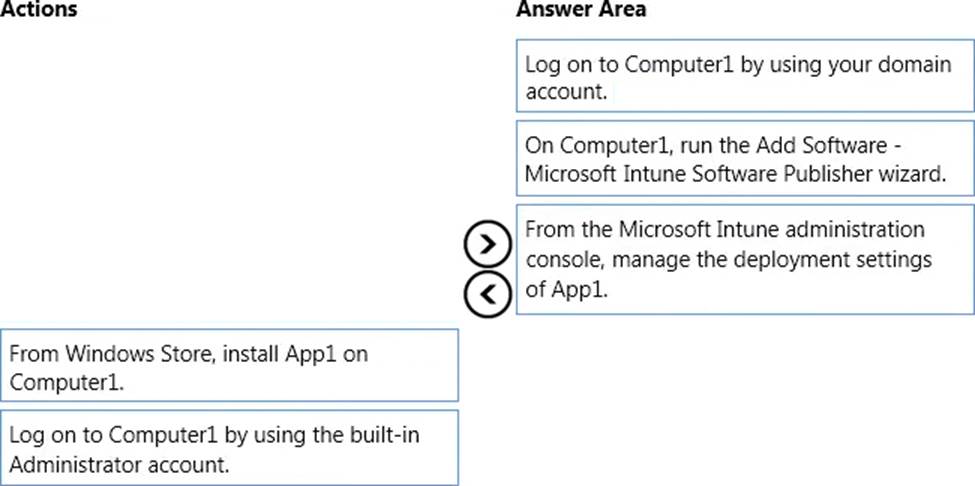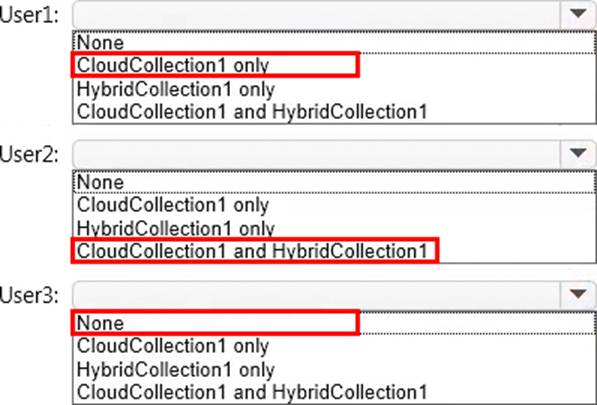Microsoft 70-697 Configuring Windows Devices Online Training
Microsoft 70-697 Online Training
The questions for 70-697 were last updated at Apr 15,2025.
- Exam Code: 70-697
- Exam Name: Configuring Windows Devices
- Certification Provider: Microsoft
- Latest update: Apr 15,2025
Topic 1, Manage identity
You support Windows 10 Enterprise computers that are members of an Active Directory domain. Your company policy defines the list of approved Windows Store apps that are allowed for download and installation.
You have created a new AppLocker Packaged Apps policy to help enforce the company policy.
You need to test the new AppLocker Packaged Apps policy before you implement it for the entire company.
What should you do?
- A . From Group Policy, enforce the new AppLocker policy in Audit Only mode.
- B . From Group Policy, run the Group Policy Results Wizard.
- C . From Group Policy, run the Group Policy Modeling Wizard.
- D . From PowerShell, run the Get-AppLockerPolicy CEffective command to retrieve the AppLocker effective policy.
You support Windows 10 Enterprise computers.
Your company has started testing Application Virtualization (App-V) applications on several laptops. You discover that the App-V applications are available to users even when the laptops are offline.
You need to ensure that the App-V applications are available to users only when they are connected to the company network.
What should you do?
- A . Change user permissions to the App-V applications.
- B . Disable the Disconnected operation mode.
- C . Configure mandatory profiles for laptop users.
- D . Reset the App-V client FileSystem cache.
HOTSPOT
You have an image of Windows 10 Enterprise named Image1. Image1 has version number 1.0.0.0 of a custom, line-of-business universal app named App1.
You deploy Image1 to Computer1 for a user named User1.
You need to update App1 to version 1.0.0.1 on Computer1 for User1 only.
What command should you run? To answer, select the appropriate options in the answer area.

DRAG DROP
You manage Microsoft Intune for a company named Contoso. You have an administrative computer named Computer1 that runs Windows 10 Enterprise. You need to add a Windows Store universal app named App1 to the Company Portal Apps list for all users.
Which three actions should you perform in sequence? To answer, move the appropriate actions from the list of actions to the answer area and arrange them in the correct order.

Your network contains an Active Directory domain named contoso.com. The domain contains Windows 10 Enterprise client computers.
Your company has a subscription to Microsoft Office 365. Each user has a mailbox that is stored in Office 365 and a user account in the contoso.com domain. Each mailbox has two email addresses.
You need to add a third email address for each user.
What should you do?
- A . From Active Directory Users and Computers, modify the E-mail attribute for each user.
- B . From Microsoft Azure Active Directory Module for Windows PowerShell, run the SetCMailbox cmdlet.
- C . From Active Directory Domains and Trust, add a UPN suffix for each user.
- D . From the Office 365 portal, modify the Users settings of each user.
HOTSPOT
You manage a Microsoft Azure RemoteApp deployment. The deployment consists of a cloud collection named CloudCollection1 and a hybrid collection named HybridCollection1. Both collections reside in a subscription named Subscription1. Subscription1 contains two Active Directory instances named AzureAD1 and AzureAD2. AzureAD1 is the associated directory of Subcsription1.
AzureAD1 is synchronized to an on-premises Active Directory forest named constoso.com. Passwords are synchronized between AzureAD1 and the on-premises Active Directory.
You have the following user accounts:

You need to identify to which collections each user can be assigned access.
What should you identify? To answer, select the appropriate options in the answer area.

Your Windows 10 Enterprise work computer is a member of an Active Directory domain. You use your domain account to log on to the computer. You use your Microsoft account to log on to a home laptop.
You want to access Windows 10 Enterprise apps from your work computer by using your Microsoft account.
You need to ensure that you are able to access the Windows 10 Enterprise apps on your work computer by logging on only once.
What should you do?
- A . Add the Microsoft account as a user on your work computer.
- B . Enable Remote Assistance on your home laptop.
- C . Connect your Microsoft account to your domain account on your work computer.
- D . Install SkyDrive for Windows on both your home laptop and your work computer.
Topic 2, Plan desktop and device deployment
You administer a Windows 10 Enterprise computer that runs Hyper-V. The computer hosts a virtual machine with multiple snapshots. The virtual machine uses one virtual CPU and 512 MB of RAM.
You discover that the virtual machine pauses automatically and displays the state as paused-critical.
You need to identify the component that is causing the error.
Which component should you identify?
- A . no virtual switch defined
- B . insufficient memory
- C . insufficient hard disk space
- D . insufficient number of virtual processors
You have a Windows 10 Enterprise computer named Computer1 that has the Hyper-V feature installed. Computer1 hosts a virtual machine named VM1. VM1 runs Windows 10 Enterprise. VM1 connects to a private virtual network switch.
From Computer1, you need to remotely execute Windows PowerShell cmdlets on VM1.
What should you do?
- A . Run the winrm.exe command and specify the Cs parameter.
- B . Run the Powershell.exe command and specify the CCommand parameter.
- C . Run the ReceiveCPSSession cmdlet and specify the CName parameter.
- D . Run the InvokeCCommand cmdlet and specify the CVMName parameter.
You deploy several tablet PCs that run Windows 10 Enterprise.
You need to minimize power usage when the user presses the sleep button.
What should you do?
- A . In Power Options, configure the sleep button setting to Sleep.
- B . In Power Options, configure the sleep button setting to Hibernate.
- C . Configure the active power plan to set the system cooling policy to passive.
- D . Disable the C-State control in the computer’s BIOS.
Latest 70-697 Dumps Valid Version with 339 Q&As
Latest And Valid Q&A | Instant Download | Once Fail, Full Refund




